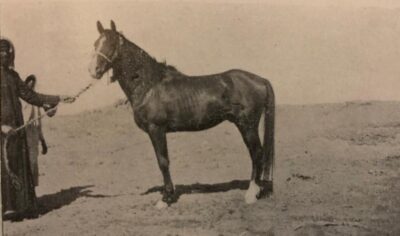Head stallion at al-Kharj in 1936
From the 1936 book of Dr. Ahmad Mabrouk of the Royal Agricultural Society of Egypt, “Rihlah ila Bilad al-‘Arab”, comes this picture of a stallion of King Abd al-‘Aziz Aal Saud at the al-Kharj stud in Najd.
Arabian horse fans would do well to carefully study the horse in this picture: he was the senior stallion in the senior stud of the most senior person in Arabia at the time. You’re looking at the archetype of the breed in its native homeland.
Note the power, length and slope of the shoulder, the pointy ears, prominent withers and the length of hip. Note the straight profile and the strong neck. Neither swan necks nor extreme dished profiles were not a thing.
Ten years later, in 1946, the archetype at al-Kharj did not look much different.

What a Horse!! This is the kind of a stallion I would like for my mares!!
It could almost have been the same horse in 1946.
so refreshing, noble and masculine
Exactly. That’s how they should be. You should be able to tell that a male is a male and a female is a female.
Said it before and I’ll say it again. He has a horse like functional slope to his hindquarters. In a fighting melee, which was what these horses were bred for, he could stop, turn and spin, and save his riders life. Because, he can tuck his hindquarters. A horse with a flat cow-like croup cannot tuck their hindquarters without frying ( destroying) their hocks over time.
best
Bruce Peek
Do we mind the slightly drooping hindquarter?
No, No a thousand times No. Horses with flat hindquarters move like cows, not horses. Dr. Hillary Clayton chose a sloping angled hindquarters Arab from Michigan State Universities herd and took him to Grand Prix in 4 years. Try that with a flat crouped horse. She usdf bronze, silver and golded,if you will., with the horse. In fact I will take what people called a drooping hindquarters horse everytime over a flat croup.
best
Bruce Peek
What about the coupling? How much of that is from malnutrition?
He’s also standing slightly under himself. If totally square it would change the rear end angle appearance a bit. Wonderful horse.
I wonder also, his back is not especially short but cannot tell if he’s weak in the loin because of the positioning/angle of the shot. I find myself thinking he’s not malnourished, his coat is shiny – so maybe he’s simply in “racing condition” – got no extra. He looks hardy, I am a repeat oogler of this picture (probably because my horse’s descend from Al Kharj in pedigree in varying percentages and I am a big fan lol, the bias is big with me).
The dip in muscling between his point of hip and last rib is self evidently there. But, you are right about the malnutrition. You can see his ribs in the photo, and we should bear in mind that cameras tend to add weight to their subjects so he is probably ,’ in real life,’ even thinner than he looks. The exercises to build up his lumbar area are, backing up small hills in hand with a lowered head- say 4 strides to start with. After each hill ascent a release and neck rub and let him graze for a few mouthfuls. Turns on the forehand and hindquarters still in hand with a release and pause to let him think and mentally process and leg stretches AFTER he has done his work.
best
Bruce Peek
That sloping croup wouldn’t look out of place in endurance stables in Namibia. Our saving grace is that the horses are also used as stock horses, so there simply no place for “flavour of the week” horses.
The show breeders (usually city folk) would argue that their pretty prancing ponies can do anything, and look down on the endurance winners as (insert expletive here)
Thanks for posting Edouard!
Wilton- you should be proud as can be of your arab bred stock horses. Useful animals that can do a job. As opposed to pasture decorations that are too refined and flighty to be a safe ride.
best
Bruce Peek
What magnificent horse. Reminds me of the superlative Faras. Both are just glorious.